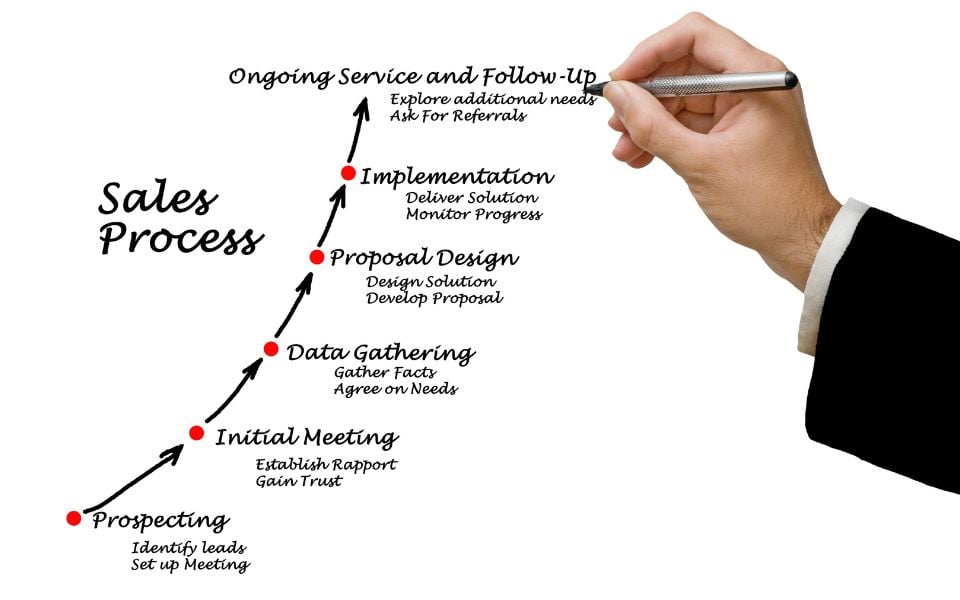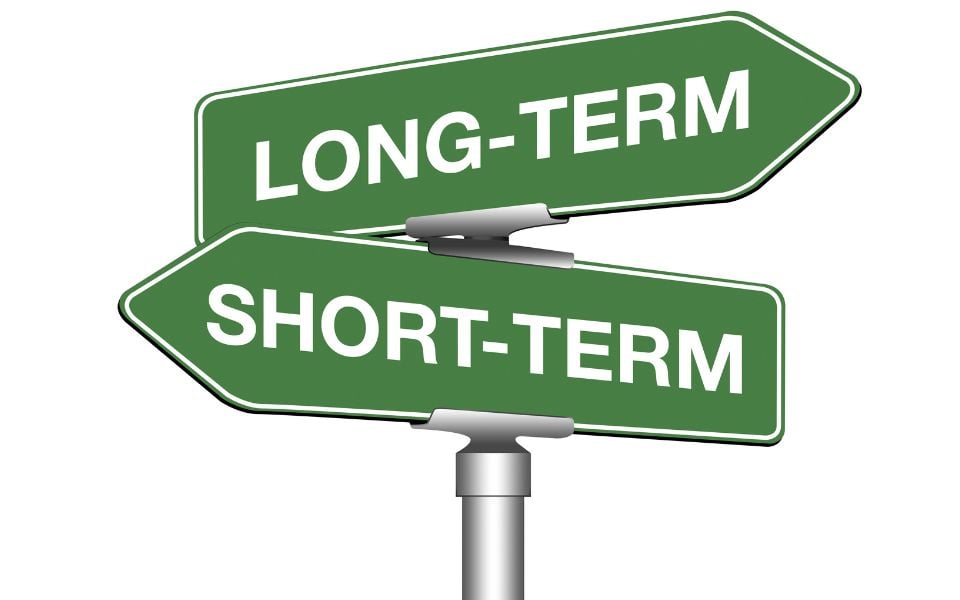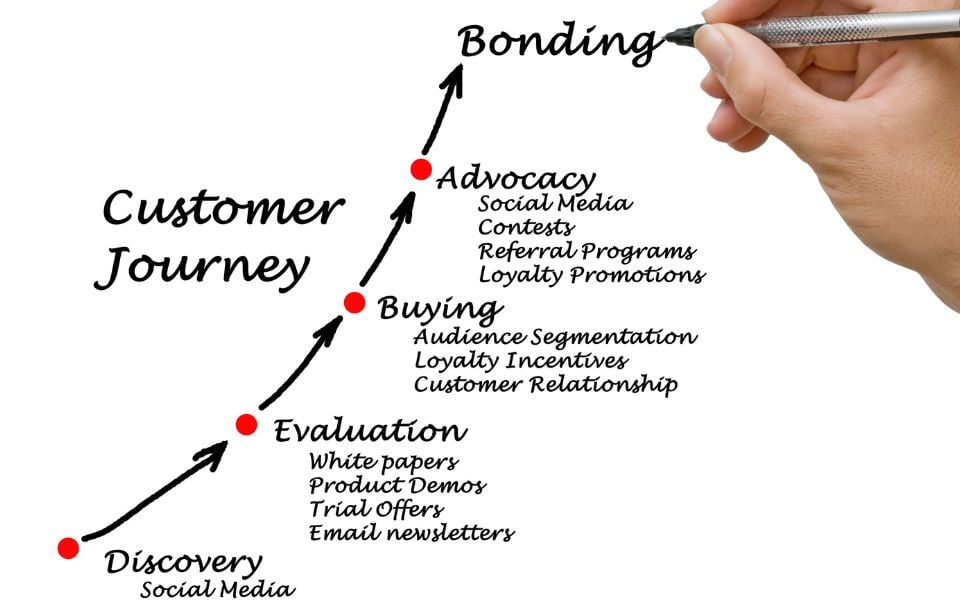Building a Sales Process that Includes Automation: Tips from the Pros
Welcome, sales managers! As a seasoned professional, you know that closing deals is the lifeblood of any business. But, have you ever felt like you're just spinning your wheels, trying to find the right leads and close deals, but never quite reaching your sales targets? It's a common problem, but the solution is simple: a well-defined sales process.
Think of building a sales process like building a house. A blueprint, or a plan, is essential to ensure that the final product is sturdy, efficient, and meets the needs of the people who will live in it. Similarly, a sales process is a blueprint for your sales efforts, helping you identify and qualify leads, manage the sales cycle, and close deals more effectively.
In this article, we'll walk you through the steps of building a sales process that works for your business, no matter the length of the sales cycle. We'll also cover the importance of incorporating sales automation to save time and increase efficiency. As a HubSpot certified partner, we'll provide examples of how HubSpot sales automation tools can help you streamline your sales efforts.

So, if you're ready to stop spinning your wheels and start building a sales process that will help you meet your sales targets and reduce labour costs, keep reading. We promise it'll be worth your while.
The Importance of a Sales Processes
A sales process is like a blueprint for a house, it provides a clear roadmap for identifying and qualifying leads, managing the sales cycle, and closing deals more effectively. Having a well-designed sales process in place can increase efficiency and reduce labour costs, allowing sales managers to focus on the most important aspects of the job, closing deals.
However, many sales managers face common pain points such as difficulty identifying which prospects are ready to buy, wasting time with prospects who are not needed or not interested in buying now and difficulty reaching sales targets. A formal sales process can help alleviate these pain points by providing a clear roadmap for identifying and qualifying leads, managing the sales cycle, and closing deals more effectively.
Steps to Building a Sales Process
Creating a sales process for a business is essential for achieving sales targets, increasing efficiency, and reducing labour costs. Each step in a sales process is like a brick in a house, it's essential to have a clear and well-defined process in place to ensure that the final product is sturdy, efficient, and meets the needs of the business.
-
Define the sales process
The first step in creating a sales process is to define the process itself, outlining the different stages and activities involved in the sales process. This includes identifying the lead generation process, the process of qualifying leads, the process of nurturing leads and closing deals.
-
Define the sales stages
The next step is to define the sales stages, outlining the different stages that a lead goes through during the sales process. This can include stages such as "prospecting," "qualifying," "presenting," "closing," and "follow-up."
-
Define the sales activities
The final step is to define the sales activities, outlining the specific tasks that need to be completed during each stage of the sales process. This can include activities such as "researching leads," "scheduling meetings," "sending proposals," and "closing deals."
It's essential to tailor the sales process to the unique needs of the business. This includes identifying the unique needs of the business, tailoring the sales process to those needs and continuously evaluating and adapting the process as the business evolves.
The Sales Cycle

The sales cycle is like the foundation of a house, it is the length of time it takes for a prospect to become a customer. Understanding the sales cycle is essential for effectively managing the sales process, as different sales cycle lengths require different strategies.
For a short sales cycle, which can be a few days, the focus should be on identifying and qualifying leads quickly and efficiently. This may involve automating repetitive tasks and streamlining the sales process to increase efficiency.
For a medium sales cycle, which can be a few weeks, the focus should be on managing leads and keeping them engaged throughout the process. This may involve creating a solid follow-up plan and leveraging marketing automation tools to nurture leads.
For a long sales cycle, which can be greater than 90 days, the focus should be on keeping leads interested and closing deals. This may involve building long-term relationships with prospects, providing personalised solutions, and leveraging sales automation tools to manage leads throughout the entire process.
It's important to remember that these are general guidelines and that each business may have a different sales cycle length and therefore require a different approach. It's essential to continuously evaluate and adapt the sales process to fit the unique needs of your business and to optimise it for the specific sales cycle length.
Understanding the sales cycle and tailoring the sales process to fit the unique needs of the business is crucial for success. Sales automation is another important aspect to consider, as it can help streamline the process and increase efficiency, regardless of the sales cycle length.
Creating a Sales Process for a Short Sales Cycle

A short sales cycle, which can be a few days, requires a focused approach to identifying and qualifying leads quickly, streamlining the sales process, and automating repetitive tasks. Building a small cottage requires a clear and efficient plan, and the same applies to a short sales cycle.
To identify and qualify leads quickly, businesses should leverage online tools and resources, create a targeted lead generation strategy and follow up promptly with leads. Utilising marketing automation tools, such as lead forms and lead magnets, can help to quickly identify and qualify leads. Additionally, using a CRM system can help to manage leads and keep track of the sales process efficiently.
Streamlining the sales process is also essential for a short sales cycle, this can be done by automating repetitive tasks such as scheduling follow-up calls and sending proposals. This can be done by using sales automation tools like HubSpot Sales, which can help to automate repetitive tasks and increase efficiency.
Finally, it is important to have a clear follow-up plan in place and execute it promptly to make the most of a short sales cycle. This can include sending targeted email campaigns, making phone calls and scheduling meetings with leads.
Sales automation is another important aspect to consider, as it can help streamline the process and increase efficiency, regardless of the sales cycle length.
Example of Sales Stages for Short Cycle
An example of sales stages for a short sales cycle (ie 3 to 7 days cycle) for a carpet cleaning business using HubSpot would include the following stages:
- Qualification: This stage involves further qualifying leads by determining their carpet cleaning needs, budget, and decision-making process. Leads can be moved to this stage by actions like filling out a form or scheduling a call.
- Carpet cleaning proposal: This stage involves creating a carpet cleaning proposal, outlining the services being offered, and the costs associated with them. Leads can be moved to this stage by actions like accepting a proposal or reviewing the pricing.
- Scheduling: This stage involves scheduling the cleaning appointment with the lead, and addressing any questions or concerns they have. Leads can be moved to this stage by actions like confirming the appointment or requesting a specific date.
- Close Won: This stage involves the lead accepting the proposal, signing the agreement and making the payment.
- Close Lost: This stage involves the lead rejecting the proposal, not signing the agreement or not making the payment.
Tips for a Short Sales Cycle
- Leverage online tools and resources: Utilising marketing automation tools, such as lead forms and lead magnets, can help to quickly identify and qualify leads. For example, using a lead form on your website can help to capture the contact information of potential leads and automatically add them to your CRM.
- Create a targeted lead generation strategy: Creating a targeted lead generation strategy is essential to identifying and qualifying leads quickly. For example, creating a targeted campaign on LinkedIn, targeting specific job titles and industries, can help to generate high-quality leads.
- Follow up promptly with leads: Following up promptly with leads is essential to making the most of a short sales cycle. For example, setting up automatic email campaigns to follow up with leads can help to keep them engaged and move them through the sales process quickly.
- Automate repetitive tasks: Automating repetitive tasks such as scheduling follow-up calls and sending proposals can help to streamline the sales process and increase efficiency. For example, using a tool like HubSpot Sales can help to automate repetitive tasks and help increase efficiency and productivity.
- Utilise lead scoring: Lead scoring is a process of assigning a numerical value to leads based on their likelihood of becoming a customer. This can help to quickly identify which leads are most likely to convert and prioritise them in the sales process. For example, using a tool like HubSpot's lead scoring feature, allows you to assign points to different criteria such as job title, industry, and website behaviour, making it easier to quickly identify and qualify leads.
- Follow up promptly: Following up promptly with leads is essential to making the most of a short sales cycle. For example, setting up automatic email campaigns to follow up with leads can help to keep them engaged and move them through the sales process quickly. Additionally, using a tool like HubSpot's sales sequences can help to automate follow-up tasks, making it easy to keep track of leads and move them through the sales process quickly.
Creating a Sales Process for a Medium Sales Cycle

A medium sales cycle, which can be a few weeks, requires a different approach than a short sales cycle, the focus should be on managing leads and keeping them engaged throughout the process. Building a medium-sized home requires a well thought-out plan, and the same applies to a medium sales cycle.
To effectively manage leads during a medium sales cycle, it's important to personalise the sales process, create targeted content, and stay in touch with leads regularly. This can include sending personalised emails, creating targeted content such as blog posts, and staying in touch with leads through regular phone calls and meetings.
Creating a solid follow-up plan is also essential for a medium sales cycle, this can be done by using marketing automation tools to nurture leads. Platforms like HubSpot, have a range of features that can help to automate follow-up tasks, and create targeted campaigns to keep leads engaged throughout the process.
It's also important to leverage marketing automation tools to nurture leads, this can be done by setting up automated email campaigns, creating targeted lead magnets and using lead scoring to prioritise leads in the sales process.
Example of Sales Stages for Medium Cycle
An example of sales stages for a medium sales cycle for a B2B software business using HubSpot would include the following stages:
- Lead Generation: This stage involves identifying and qualifying leads, capturing their contact information, and adding them to the HubSpot CRM.
- Qualification: This stage involves further qualifying leads by determining their pain points, budget, and decision-making process. Leads can be moved to this stage by actions like filling out a form or scheduling a meeting.
- Demonstration: This stage involves scheduling a demo of the software for the lead, and addressing any questions or concerns they have. Leads can be moved to this stage by actions like watching a product video or requesting a demo.
- Proposal: This stage involves creating a proposal, outlining the software and services being offered, and the costs associated with them. Leads can be moved to this stage by actions like accepting a proposal or reviewing the pricing.
- Negotiation: This stage involves negotiating the terms of the deal, and addressing any final objections or concerns from the lead. Leads can be moved to this stage by actions like scheduling a meeting to discuss contract or agreement.
- Close Won: This stage involves the lead accepting the proposal and signing the contract.
- Close Lost: This stage involves the lead rejecting the proposal or not signing
Tips for a Medium Sales Cycle
- Use the tips from short sales cycles: The tips from short sales cycles can also be applied to medium sales cycles to optimise the process. For example, using lead scoring and automated email campaigns can help to quickly identify and qualify leads and keep them engaged throughout the process.
- Sales stage escalation: Escalating leads to the next sales stage when appropriate can help to ensure that prospects do not spend too much time in a single stage and move through the sales process more efficiently. For example, using a CRM system like HubSpot can help to automatically move leads to the next stage based on their actions and interactions with the business.
- Create content addressing common sales objections: Creating content that addresses common sales objections can help to keep leads engaged and informed throughout the sales process. For example, creating a whitepaper that addresses common objections such as "the cost is too high" can help to keep leads engaged and informed as they consider their options.
- Run social media advertising using sync audiences: Running social media advertising using sync audiences can help to showcase client reviews and testimonials to leads as they consider their options. For example, using Facebook's sync audiences feature, can help to target leads based on their website behaviour and show them client reviews and testimonials.
- Monitor prospect website visits: Monitoring prospect website visits can help to notify sales reps when a lead is actively engaged in the sales process steps. For example, using a tool like HubSpot's website monitoring feature, can help to notify sales reps when a lead visits the website and allow them to follow up promptly.
Creating a Sales Process for a Long Sales Cycle
As we all know, long sales cycles can be a real challenge for businesses, especially when it comes to keeping leads engaged and moving them through the process efficiently. Just like building a mansion, creating a sales process for a long sales cycle requires a lot of planning, attention to detail, and patience.

Example of Sales Stages for Long Cycle
An example of sales stages for a long sales cycle (greater than 90 days cycle) for a construction or building company using HubSpot would include the following stages:
- Lead Generation: This stage involves identifying and qualifying leads, capturing their contact information, and adding them to the HubSpot CRM.
- Qualification: This stage involves further qualifying leads by determining their construction needs, budget, and decision-making process. Leads can be moved to this stage by actions like filling out a form or scheduling a call.
- Project Proposal: This stage involves creating a project proposal, outlining the services being offered, and the costs associated with them. Leads can be moved to this stage by actions like accepting a proposal or reviewing the pricing.
- Site visit: This stage involves scheduling a site visit with the lead, and assessing the construction needs. Leads can be moved to this stage by actions like confirming the site visit or requesting a specific date.
- Design & Plan: This stage involves creating a design plan and addressing any questions or concerns the lead might have. Leads can be moved to this stage by actions like accepting the design plan or requesting changes.
- Contract & Agreement: This stage involves finalising the deal, and getting the lead to sign a contract and agreement.
- Close Won: This stage involves the lead accepting the proposal, signing the contract and agreement.
- Close Lost: This stage involves the lead rejecting the proposal, not signing the contract or not making the agreement.
However when designing for long sales cycles it may be easier to break the sales cycle into smaller parts and take a different approach to use a prospecting team or account based marketing.
Optimising a Long Sales Cycle
There are a number of strategies that businesses can use to optimise their sales process and make the most of a long sales cycle.
Use the tips from medium sales cycles
Many of the strategies used to optimise medium sales cycles can also be applied to long sales cycles. For example, using lead scoring and automated email campaigns can help to quickly identify and qualify leads, while using marketing automation tools can help to nurture leads and keep them engaged throughout the process.
Use Account-Based Marketing (ABM)
ABM is a strategy that focuses on the specific needs and pain points of a particular target account, rather than a broader target market. By using ABM, companies can tailor their sales and marketing efforts to specific accounts and increase the chances of closing a deal. For example, using HubSpot's ABM feature, companies can create targeted campaigns and personalise the content for specific accounts.
Use a consultative approach
A consultative approach involves understanding the lead's pain points, and working with them to find the best solution. By using a consultative approach, companies can build trust and establish themselves as a valuable partner, rather than just a vendor. For example, using HubSpot's meeting scheduling feature, companies can schedule consultations with leads to understand their needs and provide a personalised solution.
Monitor and measure your progress
This can help you identify areas where you're doing well and areas that need improvement. For example, using HubSpot's analytics, companies can track their progress in real-time and make data-driven decisions to optimise their sales process.

Sales Automation
Sales automation can play an important role in sales by streamlining repetitive tasks and allowing you to focus on more high-value activities. Below a few extra ways automation can help with your sales process
Use chatbots
Chatbots can be used to provide instant assistance to leads and improve the efficiency of the sales process. For example, using HubSpot's chatbot feature, companies can automate the process of answering frequently asked questions and directing leads to the appropriate resources.
Use Sales Automation for remote teams
When working with a remote team, sales automation can help to keep everyone on the same page and reduce the need for constant communication. For example, using HubSpot's sales automation, companies can set up automated tasks and reminders for remote team members and monitor their progress remotely.
Use automation to improve forecasting
Automation can be used to improve forecasting by providing sales reps with real-time data and insights. For example, using HubSpot's analytics, companies can track sales performance in real-time and make data-driven decisions to optimise their sales process.
Conclusion
Creating a sales process and incorporating sales automation can be a daunting task, but the results are well worth the effort. A completed sales process is like a finished house - it takes time, attention to detail, and patience to build, but once completed, it provides a solid foundation for growth and success.
Throughout this article, we've discussed the importance of defining sales stages, identifying and qualifying leads quickly, nurturing leads throughout the process, and using sales automation to streamline tasks and improve the efficiency of the process. We've also provided tips for managing leads and closing deals in short, medium and long sales cycles, and how to use sales intelligence and CRM tools like HubSpot to improve sales processes.
We encourage businesses to start building their sales process and incorporating sales automation. Crocodile Marketing, a marketing automation agency and HubSpot certified partner, can help businesses with their sales process and automation. We provide HubSpot training, HubSpot automation services for sales and marketing workflows, and integration to help clients.
We can help you create a sales process that is optimised for your business and help you to save time, resources, and increase the efficiency of your sales process. Contact us today to learn more!





